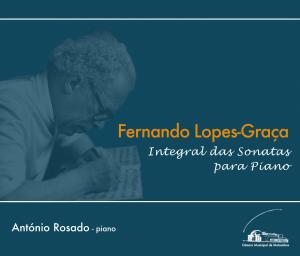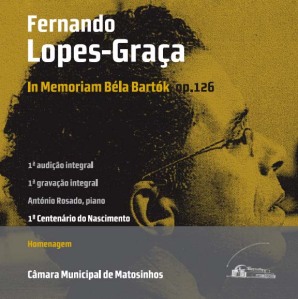NUM 1145
NUM 1143
Artist: António Rosado
Composers: Luís de Freitas Branco, Armando José Fernandes
It was Luís de Freitas Branco, towering figure of Portuguese music, who introduced modernism into the country. In the first two decades of the 20th-century, he embraced the most diverse tendencies of the time, displaying an awareness à la page rare in Portugal: before his stays in Berlin and Paris between 1910 and 1912, he had already written important works such as his 1st Sonata for violin & piano (which received the 1st prize in a composition contest presided by Viana da Mota), the post-Wagnerian symphonic poems Antero de Quental and Guerra Junqueiro, and the symbolist-tending trilogy La Mort, for voice and piano.
In 1913 the premiere of Paraísos Artificiais (Artificial Paradises from 1910) provoked a scandal in Lisbon; in that year, Luís de Freitas Branco wrote one of the most daring works of his time, Vathek. These two symphonic poems brought aspects of the avant-garde to Portuguese music: a pre-expressionist impressionism in Paradises; in Vathek, a true window is opened to the multiplicity of modernism, including an example of atonal micropolyphony which prefigures the 1960’s and 1970’s. Such daring extends to other works from the same period: the two atonal songs on poems of Mallarmé; the impressionist Preludes for piano and the String Quartet – pieces which may today be seen as a musical counterpoint to the modernism of Fernando Pessoa, Mário de Sá Carneiro, Amadeo de Souza-Cardoso and Almada Negreiros.
Beginning in the decade of the 1920’s, Luís de Freitas Branco turned towards a new diatonicism and a unique type of neoclassicism – one inspired by Beethoven – already announced in the Concerto for violin (1916). With his four symphonies, written between 1924 and 1952, Freitas Branco consolidated a Portuguese symphonic style, which had until then, only been sporadic. Use of the Portuguese language is an important contribution of his abundant vocal production, where Camões and Antero de Quental may be seen as marked exponents of his profound Humanism. The Madrigais Camonianos for a cappella choir (1930-1949) are an original evocation of the very rich Iberian polyphonic tradition; and the sonnets of Antero for voice and piano, namely the cycle «A Ideia» (“The Idea”, 1943), must be included among the supreme creations of Portuguese music of the first half of the 20th-century.
The activity of Luís de Freitas Branco was multifaceted: important pedagogue (Joly Braga Santos was his close disciple); critic; musicologist; essayist; lecturer at conferences. As an author he wrote: the first treaty of musical sciences published in Latin countries (1922); works about the technique and history of music; studies about great figures in the art of sounds and about Portuguese music.
Anticipated by Mirages, which Luís Freitas Branco composed in 1911, the famous Preludes dedicated to to Viana da Mota are an important reflection of the impressionist aesthetic in Portugal. Extrapolating the harmonic sensuality of the Romantics, these 10 pieces explore new coloristic coordinates for the instrument, integrating acquisitions associated with Debussy such as the whole tone scale, chordal prolongation, non-tertian harmony, chordal planing (parallel movement) and the importance of resonance. Although some of the preludes date from 1914, the entire cycle was concluded and received its premiere in Lisbon in the summer of 1918, performed by its dedicatee.
The whole tone scale emerges directly in the atmospheric 1st Prelude (Moderate), over arpeggios of 9th-chords. The 2nd (Animated), in an energetic and dancing ternary meter, explores chords of the added sixth. No. 3, an ABABA form, alternates a pentatonic character, with harmonies built on fifths (A) and the whole tone scale (B). A modal flavor and fan-like writing mark the meditative 4th Prelude (Moderate), while the 5th (Lively), explores turbulent sixteenth-notes in a moto perpetuo also inhabited by the whole tone scale. Particularly contemplative, the Sixth Prelude (Moderately animated) is an ABA form, with practically atonal harmonies emerging in its B section to provide contrast to the liquid parallel fourths and the static perfect fifths of its A section. The 7th Prelude (Very moderate) explores languorous chords through prolongation, over an arching melody which attempts to take flight. In No. 8 (Very animated), incessant sextuplets of sixteenth-notes serve as the basis of a whole tone fanfare which gathers melodic élan, only calming itself in a slow coda, whose final two measures are an ironic and clowning negation. The melody in parallel fourths of the 9th Prelude (Moderate, not slow) planes over sensual arpeggios of added sixth and ninth chords, contrasting with the clean and fiery contours of the two brief B sections, in an ABABA form. The nimble 10th Prelude (Lively) epitomizes the coordinates of the cycle, with cells proliferating around an eighth-note moto perpetuo.
The Sonatina represents a more neoclassic inclination, although very different form the Beethovenesque four symphonies, influenced probably by Ravel’s Sonatine of 1903. The first movement was published in the magazine A Semana Musical (The Musical Week) in 1923, with the title, Peça para Crianças (Piece for Children). The manuscript, undated, has “Piece for João” as its epigraph (his son was born on January 10th of the previous year). The version as Sonatina in three movements was published by Sassetti and neither manuscript nor published edition are dated.
Although João de Freitas Branco attributes 1930 as the the date of the Sonatina, a journal clipping dated “10/14/1923” (in Luís de Freitas Branco’s hand) is mentioned in the more recent edition of Sassetti: “Freitas Branco, our illustrious music critic, gives us, in a delicious “Sonatina” for piano, in three movements, the first Portuguese example of the sober style which marks the post-Debussy reaction. The author took advantage of the occasion to write, with his unique skill, using the major refinements of modernism including polytonality and atonality [!], a most simple work, a true Sonatina for children, as much in style as in technique. It represents, in our opinion, the resolution of one of the most difficult and interesting problems of modern art, in the ingenuous guise of a piece for the third year of the Conservatory.” [journal and author not identified].
According to the dating of this journal clipping, the Sonatina will most probably have been complete in 1922 or in the first half of 1923. The date of the premiere is indicated by João de Freitas Branco as 1930, interpreted by Maria Capucho, in Lisbon.
In this, the most miniature of works by the composer, we find a foreshadowing of the new modal orientation already in the first movement. More “geometric”, this orientation will be affirmed in the 2nd Sonata for violin. The Allegretto finale, in Rondo form, is perhaps the most Scarlattian moment in the music of Luís de Freitas Branco.
Written in 1940 and dedicated to the pianist Isabel Manso, these Four Preludes form a group completely different from the 10 Preludes dedicated to Viana da Mota. Stylistically, they emerge as a rare object within Freitas Branco’s production from the years 1930-40: an almost expressionist incursion in an elliptical and disturbing universe.
The premiere took place in 1940, by the dedicatee . Eighteen years later, a recital by the same pianist was mentioned by Nuno Barreiros: “The author once told us that the “Four Preludes” – short, synthetic, in a concentrated language – represent, within his work, a final resurrection of impressionism, the erasure of the last stains of that aesthetic, which so strongly marked the composer of “Artificial Paradises”. We experience such an impression now, through the fitting interpretation of Isabel Manso (…)” (unidentified publication, 11/24/1958).
The definition “a final resurrection of impressionism, the erasure of the last stains of that aesthetic” demands that we parse well the word “erase”. Impressionist traces are to be found in the 3rd prelude, inhabited by parallel fourths; in the remaining parts the parallel motion is of augmented 4ths and superpositions of 2nds – a deformed impressionism, with harmonies nearer to the Second Viennese School.
NUM 1124
 Title: Fernando Lopes-Graça Integral das Sonatas Para Piano
Title: Fernando Lopes-Graça Integral das Sonatas Para Piano
Artist: António Rosado
Composer: Fernando Lopes-Graça







